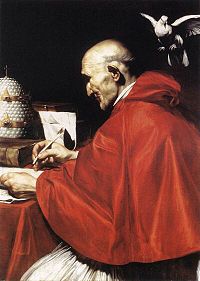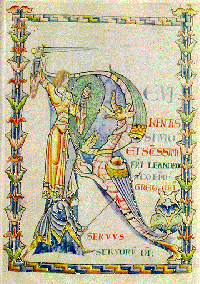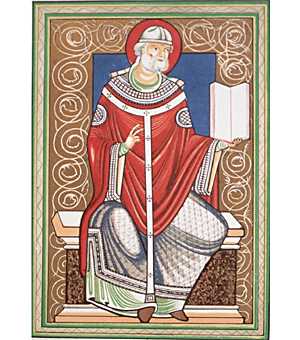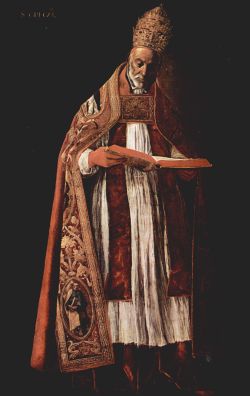Gregory I
| Pope Gregory I | |
|---|---|

| |
| Birth name | Gregory |
| Papacy began | September 3, 590 |
| Papacy ended | March 12, 604 |
| Predecessor | Pelagius II |
| Successor | Sabinian |
| Born | c. 540 Rome, Italy |
| Died | March 12 604 Rome, Italy |
| Other popes named Gregory | |
| Styles of Pope Gregory I | |

| |
| Reference style | His Holiness |
| Spoken style | Your Holiness |
| Religious style | Holy Father |
| Posthumous style | Saint |
- "Saint Gregory" redirects here.
Pope Saint Gregory I or Gregory the Great (c. 540 – March 12, 604) was pope from September 3, 590 until his death.
He is also known as Gregory Dialogus (the Dialogist) in Eastern Orthodoxy because of the Dialogues he wrote. He was the first of the Popes from a monastic background. Gregory is a Doctor of the Church and one of the four great Latin Fathers of the Church (the others being Ambrose, Augustine, and Jerome). Of all popes, Gregory I had the most influence on the early medieval church.[1] He was one of the last Popes not to have changed his name.
Biography
Early life
The exact date of Gregory's birth is uncertain, but is usually estimated to be around the year 540. He was born into a wealthy noble Roman family, in a period, however, when the city of Rome was facing a serious decline in population, wealth, and influence. His family seems to have been devout. Gregory's great-great grandfather had been Pope Felix III. Gregory's father, Gordianus, worked for the Roman Church and his father's three sisters were nuns. Gregory's mother Silvia herself is a saint. While his father lived, Gregory took part in Roman political life and at one point was Prefect of the City. However, on his father's death, he converted his family home, located on a hill just opposite the Circus Maximus, into a monastery dedicated to the apostle, St. Andrew. Gregory himself entered as a monk.
Eventually, Pope Pelagius II ordained him a deacon and solicited his help in trying to heal the schism of the Three Chapters in northern Italy. In 579, Pelagius chose Gregory as his apocrisiarius or ambassador to the imperial court in Constantinople.
Confrontation with Eutychius
In Constantinople, Gregory gained attention by starting a controversy with Patriarch Eutychius of Constantinople, who had published a treatise on the corporeality of the imminent General Resurrection, in which bodies would be incorporeal, to which Gregory contrasted the corporeality of the risen Christ. The heat of argument drew the emperor in as judge. Eutychius' treatise was condemned, and it suffered the normal fate of all heterodox texts, of being publicly burnt. On his return to Rome, Gregory acted as first secretary to Pelagius, and was elected Pope to succeed him.
Gregory as Pope
When he became Pope in 590, among his first acts were writing a series of letters disavowing any ambition to the throne of Peter and praising the contemplative life of the monks. At that time the Holy See had not exerted effective leadership in the West since the pontificate of Gelasius I. The episcopacy in Gaul was drawn from the great territorial families, and identified with them: the parochial horizon of Gregory's contemporary, Gregory of Tours, may be considered typical; in Visigothic Spain the bishops had little contact with Rome; in Italy the papacy was beset by the violent Lombard dukes and the rivalry of the Jews in the Exarchate of Ravenna and in the south. The scholarship and culture of Celtic Christianity had developed utterly unconnected with Rome, and it was from Ireland that Britain and Germany were likely to become Christianized, or so it seemed.
Servus servorum Dei
In line with his predecessors such as Dionysius, Damasus, and Leo the Great, Gregory asserted the primacy of the office of the Bishop of Rome. Although he did not employ the term "Pope," he summed up the responsibilities of the papacy in his official appellation, as "servant of the servants of God." As Benedict of Nursia had justified the absolute authority of the abbot over the souls in his charge, so Gregory expressed the hieratic principle that he was responsible directly to God for his ministry.
Gregory's pontificate saw the development of the notion of private penance as parallel to the institution of public penance. He explicitly taught a doctrine of Purgatory where a soul destined to undergo purification after death because of certain sins, could begin its purification in this earthly life, through good works, obedience and Christian conduct, making the travails to come lighter and shorter.
Gregory's relations with the Emperor in the East were a cautious diplomatic stand-off. He concentrated his energies in the West, where many of his letters are concerned with the management of papal estates. His relations with the Merovingian kings, encapsulated in his deferential correspondence with Childebert II, laid the foundations for the papal alliance with the Franks that would transform the Germanic kingship into an agency for the Christianization of the heart of Europe—consequences that remained in the future.
More immediately, Gregory undertook the conversion of the Anglo-Saxon kingdoms, where inaction might have encouraged the Celtic missionaries already active in the north of Britain. Sending Augustine of Canterbury to convert the Kingdom of Kent was prepared by the marriage of the king to a Merovingian princess who had brought her chaplains with her. By the time of Gregory's death, the conversion of the king and the Kentish nobles and the establishment of a Christian toehold at Canterbury were established.
Gregory's chief acts as Pope include his long letter issued in the matter of the schism of the Three Chapters of the bishops of Venetia and Istria. He is also known in the East as a tireless worker for communication and understanding between East and West. He is also credited with increasing the power of the papacy.
According to the Catholic Encyclopedia, he was declared a saint immediately after his death by "popular acclamation."
Liturgical reforms
In letters, Gregory remarks that he moved the Pater Noster (Our Father) to immediately after the Roman Canon and immediately before the Fraction. This position is still maintained today in the Roman Liturgy. The pre-Gregorian position is evident in the Ambrosian Rite. Gregory added material to the Hanc Igitur of the Roman Canon and established the nine Kyries (a vestigial remnant of the litany which was originally at that place) at the beginning of Mass. He also reduced the role of deacons in the Roman Liturgy.
Sacramentaries directly influenced by Gregorian reforms are referred to as Sacrementaria Gregoriana. With the appearance of these sacramentaries, the Western liturgy begins to show a characteristic that distinguishes it from Eastern liturgical traditions. In contrast to the mostly invariable Eastern liturgical texts, Roman and other Western liturgies since this era have a number of prayers that change to reflect the feast or liturgical season; These variations are visible in the collects and prefaces as well as in the Roman Canon itself.
A system of writing down reminders of chant melodies was probably devised by monks around 800 to aid in unifying the church service throughout the Frankish empire. Charlemagne brought cantors from the Papal chapel in Rome to instruct his clerics in the “authentic” liturgy. A program of propaganda spread the idea that the chant used in Rome came directly from Gregory the Great, who had died two centuries earlier and was universally venerated. Pictures were made to depict the dove of the Holy Spirit perched on Gregory's shoulder, singing God's authentic form of chant into his ear. This gave rise to calling the music "Gregorian chant." A more accurate term is plainsong or plainchant.
Sometimes the establishment of the Gregorian Calendar is erroneously attributed to Gregory the Great; however, that calendar was actually instituted by Pope Gregory XIII in 1582 by way of a papal bull entitled, Inter gravissimas.
Feast Day
The liturgical calendar of the Roman Catholic Church, revised in 1969, celebrates September 3 as the memorial of St. Gregory the Great. The previous calendar, and one still used when the traditional liturgy is celebrated, celebrates March 12. The reason for the transfer to the date of his episcopal consecration rather than his death was to transfer the celebration outside of Lent.
The Eastern Orthodox Church and Eastern Catholic Churches continue to commeorate St. Gregory on the traditional date of March 12th, which intentionally falls during Great Lent, appropriate because of his traditional association with the Divine Liturgy of the Presanctified Gifts, which is celebrated only during that liturgical season.
Saint Gregory is also honored by other churches: the Church of England commemorates him on September 3, while the Evangelical Lutheran Church in America remembers him on March 12.
A traditional procession continues to be held in Żejtun Malta in honour of Saint Gregory on the first Wednesday after Easter (a date close to his original feast day of March 12).
Works

Gregory is the only Pope between the fifth and the eleventh centuries whose correspondence and writings have survived enough to form a comprehensive corpus. "His character strikes us as an ambiguous and enigmatic one," Norman F. Cantor observed. "On the one hand he was an able and determined administrator, a skilled and clever diplomat, a leader of the greatest sophistication and vision; but on the other hand, he appears in his writings as a superstitious and credulous monk, hostile to learning, crudely limited as a theologian, and excessively devoted to saints, miracles, and relics".[2]
- Sermons (forty on the Gospels are recognized as authentic, twenty-two on Ezekiel, two on the Song of Songs)
- Dialogues, a collection of often fanciful narratives including a popular life of Saint Benedict
- Commentary on Job, frequently known even in English-language histories by its Latin title, Magna Moralia
- The Rule for Pastors, in which he contrasted the role of bishops as pastors of their flock with their position as nobles of the church: the definitive statement of the nature of the episcopal office
- Some 850 letters have survived from his Papal Register of letters. This collection serves as an invaluable primary source for these years
- In the Eastern Orthodox Church, Gregory is credited with compiling the Liturgy of the Presanctified Gifts. This liturgy is celebrated on Wednesdays, Fridays, and certain other days during Great Lent in the Eastern Orthodox and Eastern Catholic Churches which follow the Byzantine Rite
Sermon on Mary Magdalene
In a sermon whose text is given in Patrologia Latina, 76:1238‑1246, Gregory stated that he believed "that the woman Luke called a sinner and John called Mary was the Mary out of whom Mark declared that seven demons were cast" (Hanc vero quam Lucas peccatricem mulierem, Joannes Mariam nominat, illam else Mariam credimus de qua Marcus septem damonia ejecta fuisse testatur), thus identifying the sinner of Luke 7:37, the Mary of John 11:2 and 12:3 (the sister of Lazarus and Martha of Bethany), and Mary Magdalene, from whom Jesus had cast out seven demons (Mark 16:9).
While most Western writers shared this view, it was not seen as a Church teaching, but as an opinion, the pros and cons of which were discussed (see, for instance, the 1910 article on St. Mary Magdalen in The Catholic Encyclopedia). With the liturgical changes made in 1969, there is no longer mention of Mary Magdalene as a sinner in Roman Catholic liturgical materials.[3]
The Eastern Orthodox Church has never accepted Gregory's identification of Mary Magdalene with the sinful woman.
Iconography
In art Gregory is usually shown in full pontifical robes with the tiara and double cross, despite his actual habit of dress. Earlier depictions are more likely to show a monastic tonsure and plainer dress. Orthodox icons traditionally show St. Gregory vested as a bishop, holding a Gospel Book and blessing with his right hand. It is recorded that he permitted his depiction with a square halo, then used for the living. [4] A dove is his attribute, from the well-known story recorded by his friend Peter the Deacon,[5] who tells that when the pope was dictating his homilies on Ezechiel a curtain was drawn between his secretary and himself. As, however, the pope remained silent for long periods at a time, the servant made a hole in the curtain and, looking through, beheld a dove seated upon Gregory's head with its beak between his lips. When the dove withdrew its beak the pope spoke and the secretary took down his words; but when he became silent the servant again applied his eye to the hole and saw the dove had replaced its beak between his lips.[6]
This scene is shown as a version of the traditional Evangelist portrait (where the Evangelists' symbols are also sometimes shown dictating) from the tenth century onwards.[7] Usually the dove is shown whispering in Gregory's ear for a clearer composition.
The imaginative and anachronistic example at the top of this article is from the studio of Carlo Saraceni or by a close follower, ca 1610. From the Giustiniani collection, the painting is conserved in the Galleria Nazionale d'Arte Antica, Rome [2].
Alms
Gregory was famous for his charity works. He had a hospital built next to his house on the Caelian Hill to host poor people for dinner, at his expense. He also built a monastery and several oratories on the site. Today, the namesake church of San Gregorio al Celio (largely rebuilt from the original edifices during the 17th-18th centuries) remembers his work. One of the three oratories annexed, the oratory of St. Silvia, is said to lie over the tomb of Gregory's mother.
Famous quotes
- Non Angli, sed Angeli.("They are not Angles, but Angels.") said by Gregory when he first encountered blue-eyed, blond-haired English boys at a slave market, sparking his dispatching of St. Augustine to England to convert the English, according to Bede.
- Gregory himself wanted to go to England as a missionary. However, one day while praying about this and reading Sacred Scripture a locust landed upon his text. He shouted out locusta, Latin for locust, but reflecting on it he saw it as a sign from Heaven since the similar sounding loco sta means "stay in place (i.e. in Rome)."
- Pro cuius amore in eius eloquio nec mihi parco (For the love of it (referring back to uerbi = the Word = the Gospel, cf. Cod. Sang. 211 p. 193 col. 1, line 5), I do not spare myself from communicating it. (i.e. the Word = the Gospel), 'Homilies on Ezekiel', Bk 1.11.6 (cf. Cod. Sang. 211 p. 193 col. 2, lines 1-3).
Reception
In Britain, appreciation for Gregory remained strong even after his death, with him being called Gregorius noster ("our Gregory") by the British.[3][4] It was in Britain, at a monastery in Whitby, that the first full length life of Gregory was written, in c.713[5]. Appreciation of Gregory in Rome and Italy itself, however, came later, with his successor Sabinian (a secular cleric rather than a monk) rejecting his charitable moves towards the poor of Rome. In contrast to Britain, the first early vita of Gregory written in Italy was produced by John the Deacon in the 9th century.
ReferencesISBN links support NWE through referral fees
- ↑ Pope St. Gregory I at about.com
- ↑ Cantor, 1993, p. 157 (see Bibliography, below).
- ↑ Filteau, Jerry (2006), "Scholars seek to correct Christian tradition, fiction of Mary Magdalene". Retrieved 2007-10-01
- ↑ Gietmann, G. (1911), "Nimbus", The Catholic Encyclopedia, vol. XI, New York: Robert Appleton Company. Retrieved 2007-10-01
- ↑ Peter the Deacon, Vita, xxviii
- ↑ Catholic Encyclopedia article - see links, below.
- ↑ An early example is the dedication miniature from the an eleventh century manuscript of St. Gregory's Moralia in Job (Bamberg, Staatsbibliothek, MS Msc. Bibl. 84). The miniature shows the scribe, Bebo of Seeon Abbey, presenting the manuscript to the Holy Roman Emperor, Henry II. In the upper left the author is seen writing the text under divine inspiration.[1]
Bibliography
- Norman F. Cantor. The Civilization of the Middle Ages New York: Harper, 1993.
- Cavadini, John, ed., Gregory the Great: A Symposium. Notre Dame: University of Notre Dame Press, 1995.
- Dudden, Frederick H., Gregory the Great. Longmans, Green, and Co., London, 1905.
- Markus, R.A.. Gregory the Great and His World. Cambridge: University Press, 1997. ISBN 0-521-58608-9
- Leyser, Conrad. Authority and Asceticism from Augustine to Gregory the Great. Clarendon Press, Oxford: 2000.
- Richards, Jeffrey, Consul of God. Routelege & Keatland Paul, London: 1980.
- Straw, Carole E., Gregory the Great: Perfection in Imperfection. University of California Press, Berkeley: 1988
External links
- Pope St. Gregory I ("the Great") article from The Catholic Encyclopedia (contributed by C. Roger Hudleston)
- "Pope Gregory the Great and the 'Universal Bishop' Controversy"
- Gregory the Great, 'Homiliae in Ezechielem I-XXII' (online photographic images of St Gregory's 'Homilies on Ezekiel' in Codex 211 of the Stiftsbibliothek of St Gallen ('Cod. Sang. 211') which is a copy made about 850-872)
- St Gregory I, the Great Opera Omnia Full texts (in Latin)
- St Gregory Dialogus, Pope of Rome Orthodox icon and synaxarion
| Roman Catholic Popes | ||
|---|---|---|
| Preceded by: Pelagius II |
Bishop of Rome 590–604 |
Succeeded by: Sabinian |
| ||||||||||||||||
| This article is part of the Doctors of the Church series |
|
St. Gregory the Great | St.Ambrose | St. Augustine | St. Jerome | St. John Chrysostom | St. Basil | St. Gregory Nazianzus | St. Athanasius | St. Thomas Aquinas | St. Bonaventure | St. Anselm | St. Isidore | St. Peter Chrysologus | St. Leo the Great | St. Peter Damian | St. Bernard | St. Hilary of Poitiers | St. Alphonsus Liguori | St. Francis de Sales | St. Cyril of Alexandria | St. Cyril of Jerusalem | St. John Damascene | St. Bede the Venerable | St. Ephrem | St. Peter Canisius | St. John of the Cross | St. Robert Bellarmine | St. Albertus Magnus | St. Anthony of Padua | St. Lawrence of Brindisi | St. Teresa of Avila | St. Catherine of Siena | St. Thérèse of Lisieux |
Credits
New World Encyclopedia writers and editors rewrote and completed the Wikipedia article in accordance with New World Encyclopedia standards. This article abides by terms of the Creative Commons CC-by-sa 3.0 License (CC-by-sa), which may be used and disseminated with proper attribution. Credit is due under the terms of this license that can reference both the New World Encyclopedia contributors and the selfless volunteer contributors of the Wikimedia Foundation. To cite this article click here for a list of acceptable citing formats.The history of earlier contributions by wikipedians is accessible to researchers here:
The history of this article since it was imported to New World Encyclopedia:
Note: Some restrictions may apply to use of individual images which are separately licensed.



